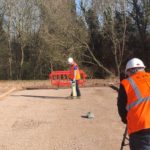Features - Business
Beyond bricks – structuring leadership teams of the future in construction

Driven by digital transformation and continued innovation, the face of the UK’s construction sector is constantly evolving. The likes of BIM and off-site manufacturing techniques are changing how the sector designs and delivers infrastructure, as well as creating efficiencies in project lifecycles.
Yet, as the sector continues to embrace digital technologies, there are potential new entrants that possess the disruptive capabilities to change the dynamics of the industry. Tech giants including Intel and Google are already investing in and leading on the construction of their own facilities such as staff accommodation blocks, data sites and manufacturing plants. While these may be internal projects, it could only be a matter of time before these heavyweights look to capitalise on the low barriers to entry in the UK construction sector.
As new advancements continue to emerge and competition ramps up across the sector, change is inevitable. Forward-thinking businesses must focus on developing and securing the right mix of leadership to achieve success.
Business acumen
For a sector once dominated by engineers and the technically-minded, business acumen has risen up the rankings to become a top priority for leadership roles in construction. Organisations that can combine specialist knowledge within their firm with leadership that can drive change and business benefits from market changes will have a winning mix. Therefore, at all levels, the industry needs to upskill and attract senior talent with business and commercial abilities.
But, ensuring a pipeline of long-term business acumen also relies on supporting future talent. Organisations are investing in future leaders by providing them with commercial and business skills, from an early point in their career. Firms such as Jacobs and Skanska are delivering this bottom-up approach to training business acumen and skills, starting with graduates.
Agility ability
In light of the anticipated pace of technology advancement, organisations will need to be more agile to adapt to new market conditions – assessing their current business value, and adapting in order to best commercialise that value in the new landscape. Historically, consultancy practices within the built environment have based their business models on their employees’ time, similar to law firms or any other consultancy-based service. However, technologies such as automation and artificial intelligence are capable of quickly carrying out labour intensive tasks – risking huge revenue losses across the sector.
Amongst the contracting industry, a systemic low-margin industry in the UK, organisations are re-thinking their delivery models in order to improve their profitability. Specialist contractors are beginning to increase their delivery capabilities and replace main contractors on projects, whilst tier 1 contractors such as Murphy Group, are beginning to commit to self-delivery. This is allowing for greater and higher margins and subsequently investment into innovation, but at a higher risk.
These changes open up new opportunities for leadership. The sector must look to increase the intellectual agility at the top-table by attracting talent capable of manoeuvring organisations through this evolving competitive arena. In some cases, this calls for a change in leadership recruitment, placing more focus on the competencies and behaviours of an individual rather than their direct experience within the sector. A thorough examination of how previous roles, fresh perspectives and results could be applied to the built environment will help firms to unlock new means of delivery and drive results. This is working for Bjorn Conway, Chief Executive of Ilke Homes. As the former practice lead and partner within the government practice for accounting giant EY, Bjorn is applying his professional services experience to a fast growing and highly innovative start-up business within the off-site construction sector. His adaptive leadership style and agile approach is allowing him to offer a fresh perspective to drive change.
‘Been there, done that’
The built environment sector is a late-adopter of digital transformation, but many other industries have made significant progress in adapting to technological change and have a track record of using it generate business benefits. Construction firms on the hunt for leadership talent should look to industries such as manufacturing, logistics and data analytics for individuals that have the skills and track record integrating technology. In 2013, Laing O’Rourke recruited the manufacturing and digital expert Graham Herries from Rolls Royce to integrate his data analytics and manufacturing expertise with construction. Casting the leadership net wider than the built environment sector will open up a range of new opportunities to develop a diverse leadership team with individuals that complement each other.
Market disruption presents an unprecedented opportunity for the built environment industry to reinvent itself and become a highly effective, productive and profitable sector. Those that wait for change will be left behind, and organisations that focus on building a business-led, brave and innovative leadership team will realise their future potential.
Article submitted by George Dobbins, a built environment leadership specialist at executive search firm Berwick Partners.
If you would like to read more articles like this then please click here.
Related Articles
More Features
- Ten years of progress on payment, pre-qualification and skills
19 May 25
The industry has made significant progress on late payment, pre-qualification, and competence since the formation
- Pagabo provides clarity on impacts of new NPPS and PPNs
12 Mar 25
The Labour government’s new National Procurement Policy Statement (NPPS) sets out strategic priorities for public
- How is the Procurement Act going to drive social value
24 Feb 25
The regulations laid out within the Procurement Act 2023 will go live today.






